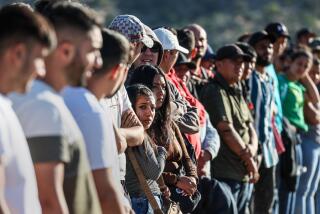Stateâs Boom Most Dramatic in Rural Areas : Census: With some exceptions, the greatest growth during the 1980s occurred in Southern California.
Californiaâs recent growth has been most remarkable not in San Diego or Los Angeles but in towns such as Palmdale and Tracy, which have exploded into cities--and in dots on the map like Adelanto and Cathedral City, which are now good-sized towns.
Cathedral City, on the edge of Palm Springs in the southern desert, wins the prize for the most rapid evolution. In 1980, the census found only 4,130 people there. The latest count, released in preliminary form this week, found 28,959--a jump of 601% in a decade.
Existing subdivisions that were absorbed when the city was incorporated in 1981 explain part ofthe growth. A building boom has filled in what were acres of vacant desert, much of it falling to development just this year.
âItâs real growth,â City Manager Joe Painter said Tuesday. âWe actually thought we were closer to 31-32,000.â
In lesser numbers, the phenomenon has been seen elsewhere in the Southern California desert and up the center of the state, in the San Joaquin Valley and along the foothills of the Sierra Nevada.
In the case of Palmdale, a surge of young home buyers has transformed the old German Lutheran settlement into a major desert city. The new census figures show that Palmdaleâs population jumped 432% since 1980.
People willing to live with extreme summer heat and occasional winter snow have also swelled Mojave Desert towns such as Hesperia, Apple Valley and Adelanto, which all tripled in population since 1980. California City more than doubled in size and Lancaster, the desertâs biggest city, nearly doubled.
With the exception of small towns such as Ripon and Patterson, which more than doubled, communities in Northern California grew more slowly than towns in the southern half of the state.
Among larger towns in the north, Tracy has undergone the biggest change. Refugees from high home prices in the San Francisco Bay Area have turned Tracy into the first Bay Area suburb to be located on the floor of the San Joaquin Valley.
Barry Hand, community development director in Tracy, said Tuesday that the cityâs location, surrounded by major interstate highways, has made it convenient for commuters to San Jose, Livermore and the East Bay Area.
âWe have real good freeway access,â Hand said, noting that the highways âform a triangle around the city.â Tracy has grown by 75% since 1980.
The Census Bureau said growth in excess of 50% was common in towns and cities up and down the Central Valley. Bakersfieldâs population swelled this decade by 62.6% and Fresno, the second largest valley city behind Sacramento, grew by 60.8%. Ceres, a town of 25,900 in Stanislaus County, grew by 95.3%.
The census figures released Monday show that, by region, Southern California remains the most populous chunk of the state with 57.6% of the people. Despite having the fastest-growing cities and towns, Southern California did not significantly increase its share of the stateâs population, which in 1980 was 56.8%.
Instead, there was a slight shift in the population balance toward the San Joaquin Valley area--which has 9.2% of the stateâs residents--and the Sierra Nevada foothill and mountain counties. The Sierra area has only 1.9% of the people, but it grew by 43.5% and towns along the mountains are undergoing dramatic change.
Overall, those inland areas--along with fast-growing Southern California deserts--are now adding people faster than the coast. From San Diego north to tiny Del Norte, 59.8% of the population is in counties that touch the Pacific. A decade ago, the coastal share was 62.1%.
The San Francisco Bay Area also is losing ground. The Bay Areaâs population nudged higher, but more slowly than the inland areas or Southern California, and its share of the stateâs population dropped from 21.8% to 20.2%.
Within Southern California, the inland shift is more pronounced and it is diminishing the importance of Los Angeles. A decade ago, Los Angeles County was home to 55.5% of the regionâs people. Now, its share has shrunk to 51.6%.
The share of Californians who call the city of Los Angeles home also continued its steady decline. In 1950, more than 18% of the state resided within Los Angeles. This year, Los Angeles contains 11.6%.
More to Read
Sign up for Essential California
The most important California stories and recommendations in your inbox every morning.
You may occasionally receive promotional content from the Los Angeles Times.










